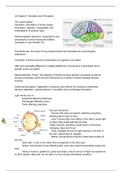Class notes
Chapter 4: Sensation and Perception
- Institution
- Carleton University (CU )
Notes for the fourth chapter of the textbook Weiten, W. & McCann, D. (2019). Psychology: Themes and Variations. Fifth Canadian Edition. Nelson Education Ltd. as well as lecture notes for sensation and perception.
[Show more]



